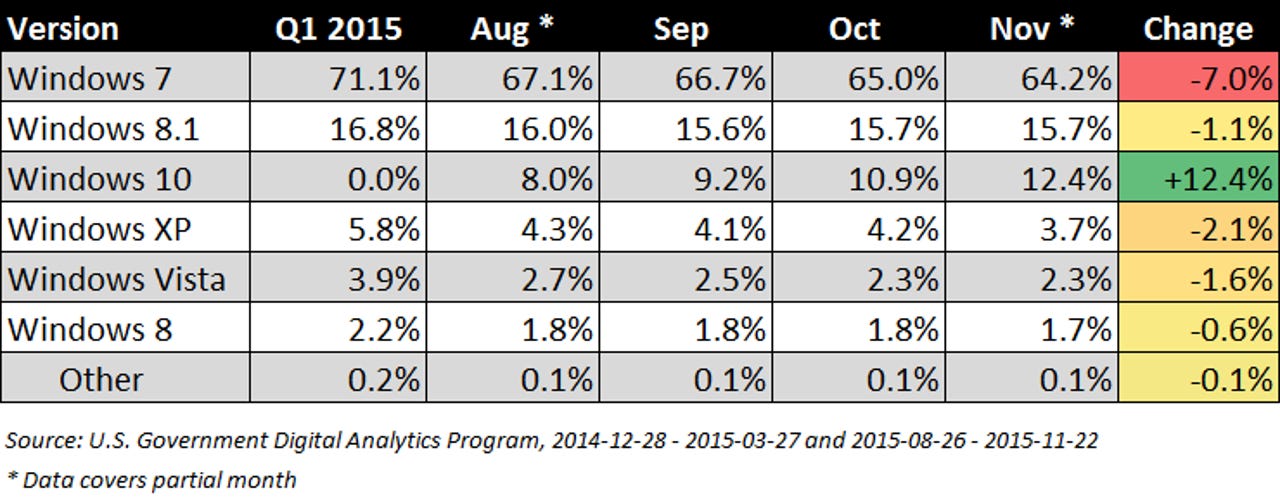U.S. Government data shows Windows 10 usage climbing as Windows 7 share drops sharply

Back in March, I took a close look at a treasure trove of data from the Digital Analytics Program (DAP), a customized version of Google Analytics that collects information from visitors to 3800 total websites run by U.S. Government agencies. Snapshots of the data are released to the public domain on the analytics.usa.gov website, which is powered by open source software.
This dataset is an amazingly broad and diverse sample of content that cuts broadly across categories, including ordinary citizens as well as those doing business with the government. (For more details, see the note at the end of this post.)
Now that Windows 10 has been in public release for nearly four months, I decided this week to take a look at the latest DAP figures. The 90-day slice of raw data represents more than 1.5 billion visits from businesses and consumers worldwide, using a variety of hardware: PCs, Macs, and mobile devices. (For the sake of comparison, that is nearly identical to the total number of visits logged in the first quarter of 2015.)
A few things remain more or less the same.
About two-thirds of visitors use PCs and Macs, with the remaining third arriving via mobile devices or tablets.
Roughly 85 percent of the visitors from desktops and laptops are using Windows, but the versions they're using today are dramatically different from the mix we saw in early 2015.

As you can see, usage of Windows 10 has risen sharply, from zero at the start of the year to 12.4 percent today. That means 1 in 8 desktop PCs visiting the broad mix of U.S. Government websites are doing so on PCs running Windows 10.
After a huge spike in the first month after the July 29 release, Windows 10 usage has continued to climb steadily, averaging about 1.5 percent per month. I expect that number to increase over the next few months, as new Windows 10 PCs sold in Q4 join the population along with upgrades to existing consumer and business desktops and laptops.
Every other version of Windows has seen a sharp decline in usage, with a significant drop for Windows 7. The decline of 7.0 percent still leaves Windows 7 as the world's most popular operating system, but the downward momentum is clear.
The declines in usage for Windows XP and Windows Vista are even steeper. Collectively, those two legacy OSes accounted for nearly 10 percent of all traffic in the first quarter of 2015. In the past 90 days, that number totals 6 percent, which suggests that about 40 percent of those mostly old PCs have been retired or replaced this year.
OS X usage hasn't budged since the beginning of the year, Linux usage remains flat, at about 1 percent, but Chrome OS usage is up significantly. In the last week of August, Chromebooks accounted for 0.9 percent of visits to the government's network of sites. With the beginning of the new school year in September, those numbers began to rise sharply, reaching 1.6% in the first three weeks of November. The timing of that growth spurt suggests that Chromebooks really are making a dent in the education market.
Because the Digital Analytics Program makes the full details of its 90-day data slices available for download, I was able to take one interesting slice of the data by comparing weekend visits with those for weekdays, over a six-week period from October through mid-November. Presumably, the Monday-through-Friday traffic includes a lot of activity on PCs in businesses, with home computers predominating on the weekend.
Judging by the data, Windows 7 is well on its way to being eclipsed by more modern operating systems among consumers, with less than 50 percent of weekend traffic from PCs coming from Windows 7.
But even in the weekday-only slice, Windows 10 is well above 10 percent usage, with Windows XP shrinking to under 4 percent.
Some notes about the data:
The DAP dataset includes a broad mix of consumer and business sites. It's obviously not a perfect mirror of the worldwide Internet, but it represents a large and very diverse sample that allows detailed comparisons over time.
Back in March, the Internal Revenue Service was the number-one destination in the DAP dataset. Now that last year's tax season is in the rearview mirror, the National Weather Service is at the top of the list, where its forecast pages, including one optimized for mobile devices, are among the most popular on the web. The list of top sites also includes the Social Security Administration and the Bureau of Labor Statistics, the National Parks Service, Whitehouse.gov, and of course NASA's Astronomy Picture of the Day (which is one of the most popular sites on the entire Web).
Lots of average citizens use government websites to get their passports and find travel information (visas and airline safety, for example, as well as travel advisories). There are also people checking in for work-related activities, just as people in the private sector do.
Most consumer-based analytics services are based on advertising, which means b-to-b sites in the insurance industry or banking or retailing are undercounted. This data isn't driven by ads but by information.